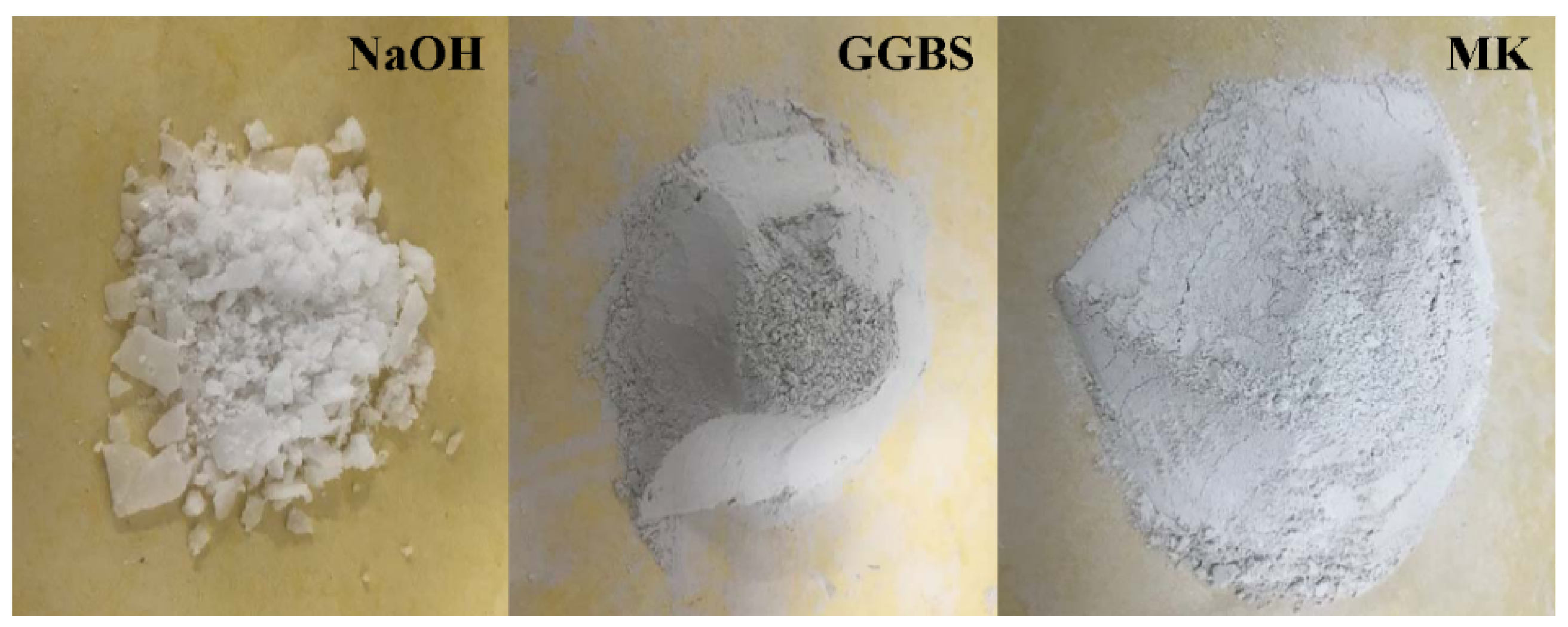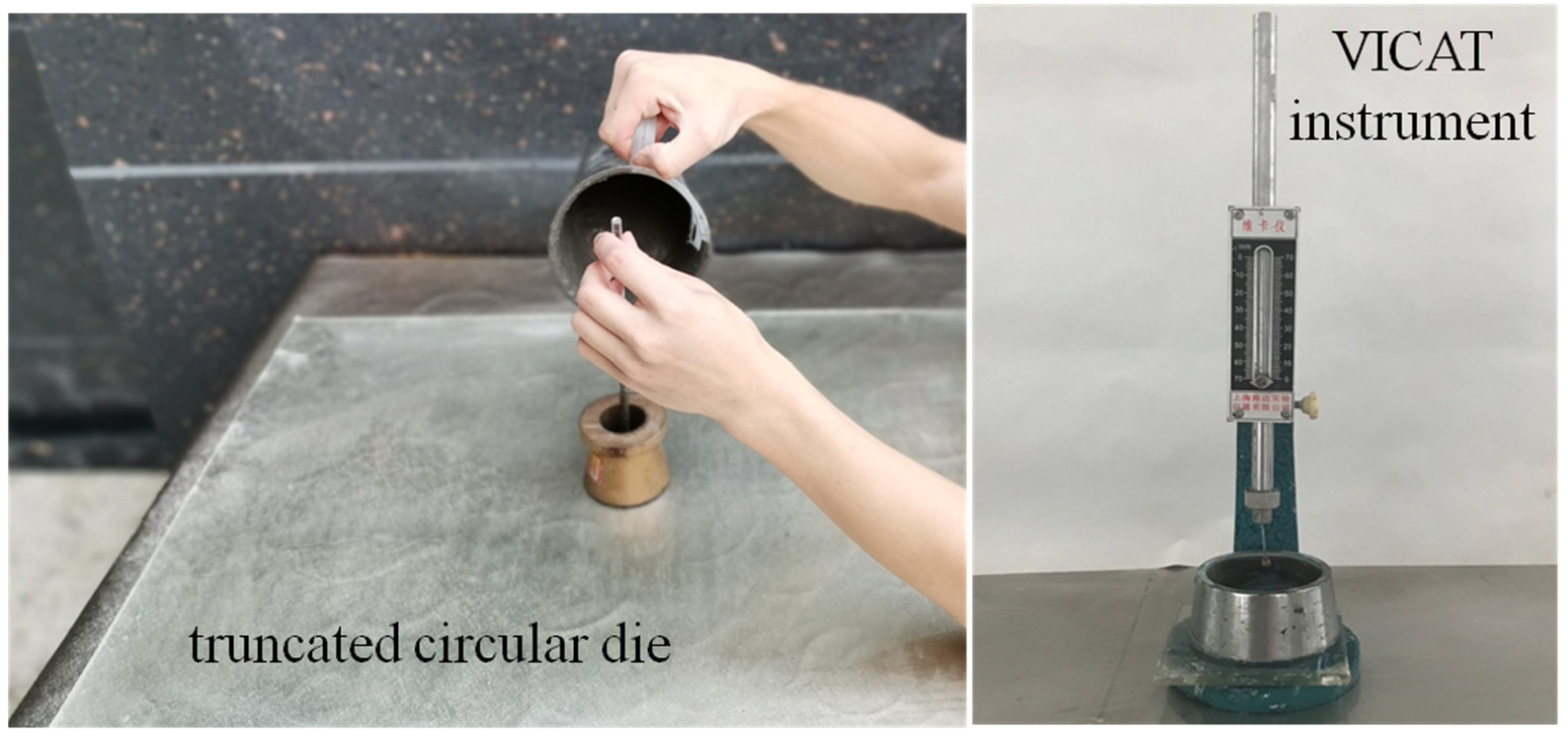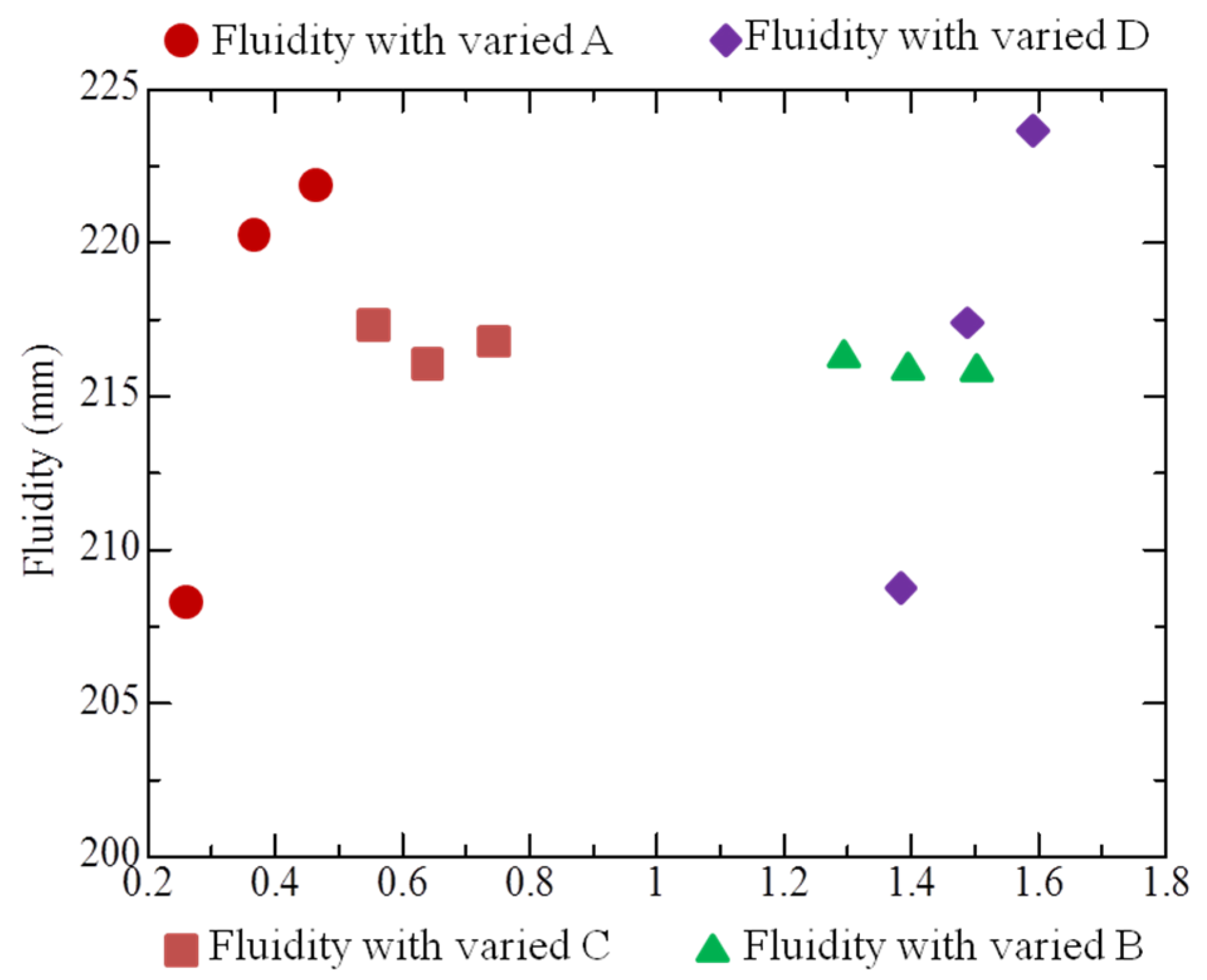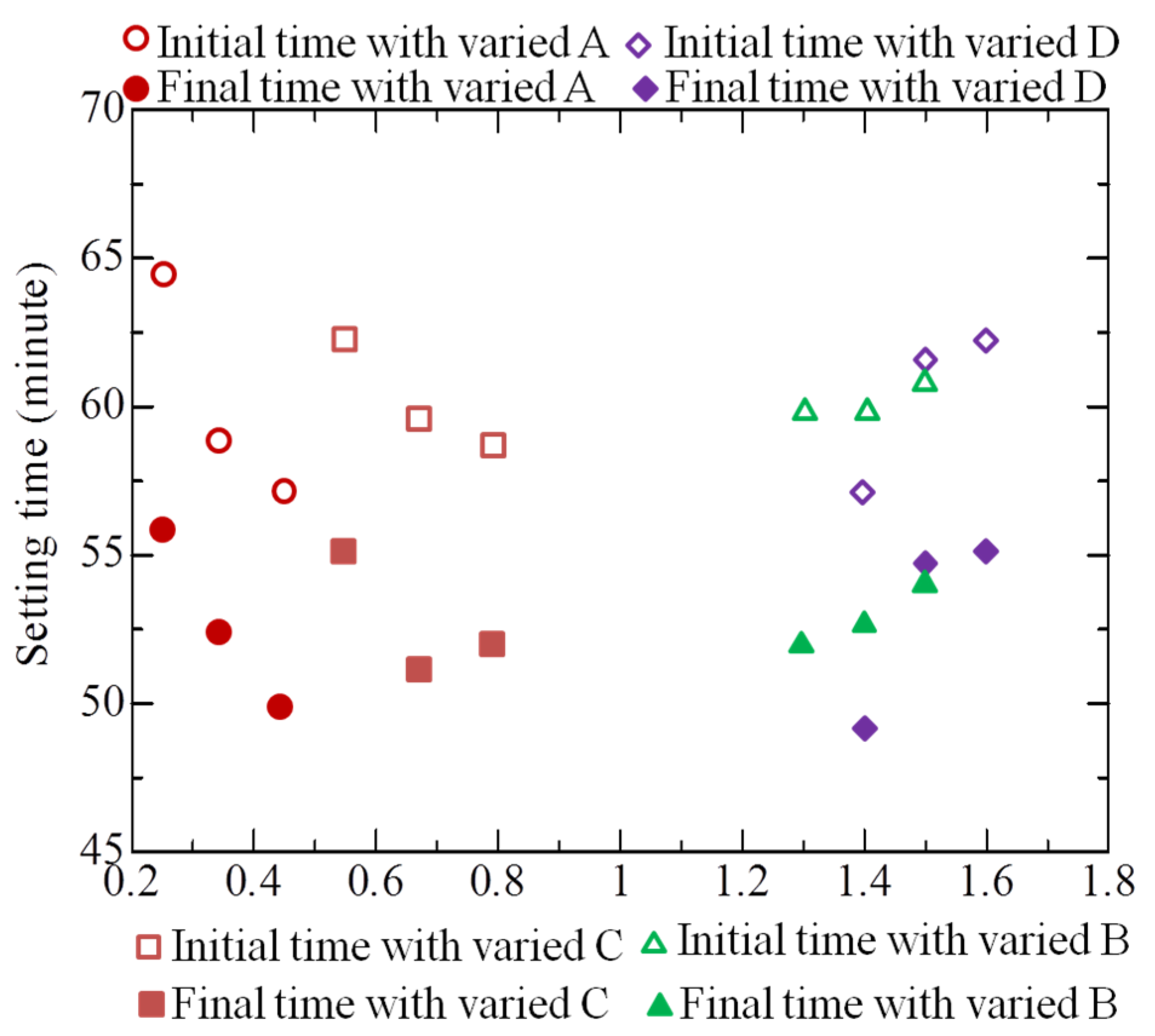Performance Investigation of Geopolymer Grouting Material with Varied Mix Proportions
Abstract
:1. Introduction
2. Experiment Design of Geopolymer Material with Varied Mass Fractions of Raw Materials in Mix Proportions
2.1. Selected Raw Materials in Geopolymer
2.2. Design of Experimental Scheme
2.3. Setup and Specimen Characteristics
3. Performance Variation of Geopolymer Material with Varied Mix Proportions
3.1. Test Results
3.2. Working Performance Variation
3.3. Mechanical Strength Variation
4. Performance of Geopolymer Material with Recommended Mix Proportion
5. Conclusions
- (1)
- Both sodium silicate modulus and activator concentration have little effect on the working performance of geopolymer, whereas both GGBS content and the mass ratio of activator solution to solid have influence on the working performance of geopolymer, in which the variance analysis demonstrates that the fluidity is dominantly affected by the mass ratio of activator solution to solid, and the setting time is mainly influenced by GGBS content.
- (2)
- Both sodium silicate modulus and the mass ratio of activator solution to solid have little effect on the mechanical strength of geopolymer, whereas both GGBS content and activator concentration have influence on the mechanical strength of geopolymer, in which the variance analysis demonstrates that the mechanical strength is mainly affected by activator concentration.
- (3)
- The geopolymer material with the recommended mix proportion has good fluidity and appropriate setting time for slurry diffusion in grouting operations and the ultra-early-stage mechanical strength of the recommended geopolymer material adequately satisfies the requirement of grouting application, in which a dense internal structure can be observed in the image obtained by scanning electron microscope (SEM).
- (4)
- Considering the working performance of the fresh grout and the physical strength of the slurry stone body, the optimal mass fractions of raw materials in mix proportion of geopolymer material used for grouting operation is suggested, in which the replacement rate of mineral powder is 45%, sodium silicate modulus and activator concentration are 1.5 and 75%, respectively, and the mass ratio of activator solution to solid is 1.5.
- (5)
- Compared with the traditional pure cement grout, the geopolymer grouting material has obvious advantages in rapid construction or repairing work, as well as green and environmental protection, mainly manifested in the strong early mechanical strength of the slurry stone body and excellent working performances of fluidity and setting time, as well as good stability without liquid precipitation, in which the setting time is far less than 2 h.
- (6)
- In the recommended mix proportion, the geopolymer material has excellent comprehensive performance to implement grouting operation, in which the compressive and tensile strengths of the stone body reach 12.2 MPa and 0.8 MPa in 4 h, and those reach 21.2 MPa and 2.1 MPa in 24 h. The fluidity is 223 mm, the initial setting and final setting times are 50 min and 57 min, respectively, and the slurry stability of geopolymer material is good. Specifically, the aforementioned 4 h compressive strength of slurry stone body in the geopolymer grouting material with recommended mix proportion can reach 12.2 MPa, which has an obvious advantage over existing geopolymer material.
Author Contributions
Funding
Institutional Review Board Statement
Informed Consent Statement
Data Availability Statement
Conflicts of Interest
References
- Zhang, C.; Yang, J.S.; Fu, J.Y.; Wang, S.Y.; Yin, J.; Xie, Y.P.; Li, L.Y. Cement based eco-grouting composite for pre-reinforcement of shallow underground excavation in vegetation protection area. Tunn. Undergr. Space Technol. 2021, 118, 104188. [Google Scholar] [CrossRef]
- Atis, C.D.; Bilim, C.; ÇElik, Ö.; Karahan, O. Influence of activator on the strength and drying shrinkage of alkali-activated slag mortar. Constr. Build. Mater. 2009, 23, 548–555. [Google Scholar] [CrossRef]
- Brough, A.R.; Atkinson, A. Sodium silicate-based, alkali-activated slag mortars: Part I. strength, hydration and microstructure. Cem. Concr. Res. 2002, 32, 865–879. [Google Scholar] [CrossRef]
- Burciaga-DíAz, O.; Magallanes-Rivera, R.X.; Escalante-GarcíA, J.I. Alkali-activated slag-metakaolin pastes: STRENGTH, structural, and microstructural characterization. J. Sustain. Cem. Based Mater. 2013, 2, 111–127. [Google Scholar] [CrossRef]
- Yao, Z.G.; Fang, Y.; Yu, T.; Pu, S.; Luo, H.; Cui, J.; Wang, J. Dynamic failure mechanism of tunnel under rapid unloading in jointed rockmass: A case study. Eng. Fail. Anal. 2022, 141, 106634. [Google Scholar] [CrossRef]
- Yao, C.F.; He, C.; Huang, X.; Takemura, J.; Yang, W.B.; An, Z.L. Response of a continuous pipeline in sand subjected to normal faulting. Transp. Geotech. 2022, 36, 100824. [Google Scholar] [CrossRef]
- He, C.; Feng, K.; Fang, Y.; Jiang, Y.C. Surface settlement caused by twin-parallel shield tunnelling in sandy cobble strata. J. Zhejiang Univ. Sci. A 2012, 13, 858–869. [Google Scholar] [CrossRef]
- Wang, S.M.; Lin, Z.Y.; Peng, X.Y.; Wang, X.M.; Tu, G.; Song, Z.H. Research and evaluation on Water-dispersion resistance of synchronous grouting slurry in shield tunnel. Tunn. Undergr. Space Technol. 2022, 129, 104679. [Google Scholar] [CrossRef]
- Kumar, S.; Kumar, R.; Mehrotra, S.P. Influence of granulated blast furnace slag on the reaction, structure and properties of fly ash based geopolymer. J. Mater. Sci. 2009, 45, 607–615. [Google Scholar] [CrossRef]
- Provis, J.L.; Bernal, S.A. Geopolymers and related alkali-activated materials. Annu. Rev. Mater. Res. 2014, 44, 299–327. [Google Scholar] [CrossRef]
- Vavričuk, A.; Bokan-Bosiljkov, V.; Kramar, S. The influence of metakaolin on the properties of natural hydraulic lime-based grouts for historic masonry repair. Constr. Build. Mater. 2018, 172, 706–716. [Google Scholar] [CrossRef]
- Emdadi, Z.; Asim, N.; Amin, M.H.; Yarmo, M.A.; Maleki, A.; Azizi, M.; Sopian, K. Development of green geopolymer using agricultural and industrial waste materials with high water absorbency. Appl. Sci. 2017, 7, 514. [Google Scholar] [CrossRef] [Green Version]
- Wang, M.; Jia, D.; He, P. Influence of calcination temperature of kaolin on the structure and properties of final geopolymer. Mater. Lett. 2010, 64, 2551–2554. [Google Scholar] [CrossRef]
- Nadoushan, M.J.; Ramezanianpour, A.A. The effect of type and concentration of activator on flowability and compressive strength of natural pozzolan and slag-based geopolymers. Constr. Build. Mater. 2016, 111, 337–347. [Google Scholar] [CrossRef]
- Peng, H.; Li, S.L.; Cai, C.S.; Zhang, X.F.; Cui, C. Study on Effect of Mix and Curing Conditions on the Mechanical Properties and Setting Time of Metakaolin-Based Geopolymer. Bull. Chin. Ceram. Soc. 2014, 33, 2809–2817. [Google Scholar]
- Ghafoori, N.; Najimi, M.; Radke, B. Natural pozzolan-based geopolymers for sustainable construction. Environ. Earth Sci. 2016, 75, 1110. [Google Scholar] [CrossRef]
- Guo, X.; Shi, H.; Dick, W.A. Compressive strength and microstructural characteristics of class C fly ash geopolymer. Cem. Concr. Compos. 2010, 32, 142–147. [Google Scholar] [CrossRef]
- Soutsos, M.; Boyle, A.P.; Vinai, R.; Hadjierakleous, A.; Barnett, S.J. Factors influencing the compressive strength of fly ash based geopolymers. Constr. Build. Mater. 2016, 110, 355–368. [Google Scholar] [CrossRef] [Green Version]
- Temuujin, J.; Riessen, A.V.; Mackenzie, K.J.D. Preparation and characterization of fly ash based geopolymer mortars. Constr. Build. Mater. 2010, 24, 1906–1910. [Google Scholar] [CrossRef]
- Puligilla, S.; Mondal, P. Role of slag in microstructural development and hardening of fly ash-slag geopolymer. Cem. Concr. Res. 2013, 43, 70–80. [Google Scholar] [CrossRef]
- Liu, Y.; Zhu, W.; Yang, E.H. Alkali-activated ground granulated blast-furnace slag incorporating incinerator fly ash as a potential binder. Constr. Build. Mater. 2016, 112, 1005–1012. [Google Scholar] [CrossRef]
- Buchwald, A.; Hilbig, H.; Kaps, C. Alkali-activated metakaolin-slag blends-performance and structure in dependence of their composition. J. Mater. Sci. 2007, 42, 3024–3032. [Google Scholar] [CrossRef]
- Heah, C.; Kamarudin, H.; Bakri, A.M.; Bnhussain, M.; Luqman, M.; Nizar, I.K.; Ruzaidi, C.M.; Liew, Y.M. Study on solids-to-liquid and alkaline activator ratios on kaolin-based geopolymers. Constr. Build. Mater. 2012, 35, 912–922. [Google Scholar] [CrossRef]
- Alonso, S.; Palomo, A. Alkaline activation of metakaolin and calcium hydroxide mixtures: Influence of temperature, activator concentration and solids ratio. Mater. Lett. 2011, 47, 55–62. [Google Scholar] [CrossRef]
- Alonso, S.; Palomo, A. Calorimetric study of alkaline activation of calcium hydroxide-metakaolin solid mixtures. Cem. Concr. Res. 2001, 31, 25–30. [Google Scholar] [CrossRef]
- Kazea, C.R.; Djobob, J.N.Y.; Nanae, A. Effect of silicate modulus on the setting, mechanical strength and microstructure of iron-rich aluminosilicate (laterite) based-geopolymer cured at room temperature. Ceram. Int. 2018, 44, 21442–21450. [Google Scholar] [CrossRef]
- Hadi, M.N.S.; Al-Azzawi, M.; Yu, T. Effects of fly ash characteristics and alkaline activator components on compressive strength of fly ash-based geopolymer mortar. Constr. Build. Mater. 2018, 175, 41–54. [Google Scholar] [CrossRef]
- Robayo-Salazar, R.A.; GutiéRrez, R.M.D.; Puertas, F. Effect of metakaolin on natural volcanic pozzolan-based geopolymer cement. Appl. Clay Sci. 2016, 132, 491–497. [Google Scholar] [CrossRef]
- Peng, H.; Ge, Y.P.; Cai, C.S.; Zhang, Y.X.; Liu, Z. Mechanical properties and microstructure of graphene oxide cement-based composites. Constr. Build. Mater. 2019, 194, 102–109. [Google Scholar] [CrossRef]
- Morsy, M.; Alsayed, S.; Al-Salloum, Y.; Almusallam, T. Effect of sodium silicate to sodium hydroxide ratios on strength and microstructure of fly ash geopolymer binder. Arab. J. Sci. Eng. 2014, 39, 4333–4339. [Google Scholar] [CrossRef]
- De Silva, P.; Sagoe-Crenstil, K.; Sirivivatnanon, V. Kinetics of geopolymerization: Role of Al2O3 and SiO2. Cem. Concr. Res. 2007, 37, 512–518. [Google Scholar] [CrossRef]
- Zou, G.; Xu, J.; Wu, C. Evaluation of factors that affect rutting resistance of asphalt mixes by orthogonal experiment design. Int. J. Pavement Eng. Technol. 2017, 10, 282–288. [Google Scholar] [CrossRef]
- Wang, J.; Zhang, L.W.; Feng, X.; Zhao, S.L.; Wang, H.B. Me Experiment and application research on alkali-activated geopolymer two-component grouting material. Chin. J. Rock Mech. Eng. 2015, 34, 4418–4425. (In Chinese) [Google Scholar]
- Peng, H.; Cui, C.; Cai, C.S.; Li, S.L.; Zhao, J.W. Mechanism of activator concentration influencing properties of metakaolin-based geopolymer. Acta Mater. Compos. Sin. 2016, 33, 2952–2960. (In Chinese) [Google Scholar]







| Mass Fraction of Compositions (%) | |||||||||
|---|---|---|---|---|---|---|---|---|---|
| MK | SiO2 | Al2O3 | Na2O | TiO2 | K2O | MgO | Fe2O3 | CaO | LOI |
| 44.29 | 37.22 | 0.62 | 0.5 | 0.13 | 0.14 | 0.36 | 0.39 | 14.98 | |
| GGBS | CaO | SiO2 | Al2O3 | MgO | SO3 | TiO2 | MnO | Fe2O3 | K2O |
| 36.91 | 33.98 | 15.22 | 9.27 | 1.81 | 0.80 | 0.59 | 0.62 | 0.41 | |
| Scheme | Factor Compositions | |||
|---|---|---|---|---|
| A | B | C | D | |
| 1 | 25% | 1.3 | 55% | 1.4 |
| 2 | 25% | 1.4 | 65% | 1.5 |
| 3 | 25% | 1.5 | 75% | 1.6 |
| 4 | 35% | 1.3 | 65% | 1.6 |
| 5 | 35% | 1.4 | 75% | 1.4 |
| 6 | 35% | 1.5 | 55% | 1.5 |
| 7 | 45% | 1.3 | 75% | 1.5 |
| 8 | 45% | 1.4 | 55% | 1.6 |
| 9 | 45% | 1.5 | 65% | 1.4 |
| Scheme | 4 h (MPa) | 8 h (MPa) | 12 h (MPa) | 16 h (MPa) | 20 h (MPa) | 24 h (MPa) | ||||||
|---|---|---|---|---|---|---|---|---|---|---|---|---|
| fc | ft | fc | ft | fc | ft | fc | ft | fc | ft | fc | ft | |
| 1 | 1.8 | 0.5 | 2.4 | 0.5 | 1.7 | 0.6 | 2.5 | 0.6 | 2.3 | 0.7 | 2.2 | 1.2 |
| 2 | 4.4 | 0.2 | 6.1 | 0.6 | 6.1 | 0.9 | 7.4 | 1.3 | 7.6 | 1.3 | 9.6 | 1.6 |
| 3 | 5.1 | 0.8 | 7.2 | 0.9 | 8.5 | 1.2 | 10.8 | 1.6 | 12.2 | 1.8 | 13.4 | 2.0 |
| 4 | 4.2 | 0.7 | 5.3 | 1.1 | 6.0 | 1.2 | 7.1 | 1.4 | 9.3 | 1.6 | 10.8 | 1.7 |
| 5 | 7.6 | 0.7 | 9.5 | 0.9 | 10.2 | 1.2 | 14.2 | 1.5 | 16.8 | 2.0 | 18.6 | 2.3 |
| 6 | 1.4 | 0.3 | 1.8 | 0.5 | 2.1 | 0.6 | 2.2 | 0.8 | 3.5 | 0.9 | 3.8 | 1.0 |
| 7 | 12.2 | 0.8 | 14.1 | 1.2 | 18.0 | 1.7 | 19.5 | 1.9 | 20.8 | 2.0 | 21.2 | 2.1 |
| 8 | 0.5 | 0.5 | 0.9 | 0.6 | 1.4 | 0.7 | 2.0 | 0.8 | 3.4 | 1.2 | 4.1 | 1.4 |
| 9 | 6.2 | 1.1 | 8.9 | 1.2 | 10.1 | 1.6 | 11.8 | 1.6 | 12.7 | 1.7 | 14.1 | 1.8 |
| Scheme | Factor Compositions | Fluidity (mm) | Setting Time (min) | ||||
|---|---|---|---|---|---|---|---|
| A | B | C | D | Initial Setting | Final Setting | ||
| 1 | 0.25 | 1.3 | 55% | 1.4 | 201 | 54 | 63 |
| 2 | 0.25 | 1.4 | 65% | 1.5 | 208 | 56 | 65 |
| 3 | 0.25 | 1.5 | 75% | 1.6 | 215 | 59 | 66 |
| 4 | 0.35 | 1.3 | 65% | 1.6 | 227 | 52 | 60 |
| 5 | 0.35 | 1.4 | 75% | 1.4 | 212 | 48 | 54 |
| 6 | 0.35 | 1.5 | 55% | 1.5 | 221 | 58 | 63 |
| 7 | 0.45 | 1.3 | 75% | 1.5 | 223 | 50 | 57 |
| 8 | 0.45 | 1.4 | 55% | 1.6 | 229 | 54 | 61 |
| 9 | 0.45 | 1.5 | 65% | 1.4 | 213 | 46 | 54 |
| Composition | Fluidity (mm) | Setting Time (min) | Strength (MPa) | |||||||
|---|---|---|---|---|---|---|---|---|---|---|
| Compressive | Tensile | |||||||||
| A | B | C | D | Initial | Final | 4 h | 24 h | 4 h | 24 h | |
| 45% | 1.3 | 75% | 1.5 | 223 | 49 | 57 | 12.2 | 21.2 | 0.8 | 2.1 |
Publisher’s Note: MDPI stays neutral with regard to jurisdictional claims in published maps and institutional affiliations. |
© 2022 by the authors. Licensee MDPI, Basel, Switzerland. This article is an open access article distributed under the terms and conditions of the Creative Commons Attribution (CC BY) license (https://creativecommons.org/licenses/by/4.0/).
Share and Cite
Liu, J.; Feng, H.; Zhang, Y.; Zheng, K. Performance Investigation of Geopolymer Grouting Material with Varied Mix Proportions. Sustainability 2022, 14, 13046. https://doi.org/10.3390/su142013046
Liu J, Feng H, Zhang Y, Zheng K. Performance Investigation of Geopolymer Grouting Material with Varied Mix Proportions. Sustainability. 2022; 14(20):13046. https://doi.org/10.3390/su142013046
Chicago/Turabian StyleLiu, Jianwei, Han Feng, Yongxing Zhang, and Kaiqi Zheng. 2022. "Performance Investigation of Geopolymer Grouting Material with Varied Mix Proportions" Sustainability 14, no. 20: 13046. https://doi.org/10.3390/su142013046





